Your mold report is complete! You can print your report by clicking the "Print" button.



Candida
Discovery location:Human skin
Date of discovery:
Candida is a type of yeast. It has a round shape and consists of a single cell. It naturally occurs in and on the human body (such as on our skin, and inside our mouths and stomachs), and helps maintain a healthy environment inside our intestines and boosts our immunity.Just like with yeast, candida cells multiply from a single cell by sprouting a bud and dividing to form more cells.
As well as candida, there are many other microorganisms that live in our bodies, all existing in balance. When we feel a bit under the weather, this balance is disrupted, and candida increases out of proportion to everything else, which sometimes can leading to making us ill.
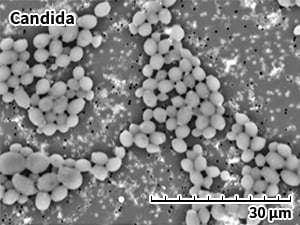
Shiitake mushroom spores
Discovery location:Shiitake mushroom
Date of discovery:
Mushrooms are a type of fungi, just like mold. They don't reproduce using seeds like plants do — instead they use spores.As the spores grow, fibers called "hyphae" grow and stretch outward. Lots of these individual hyphae clump together to form the mushroom's cap and stalk. The spores are released from the underside of the mushroom's cap.
This is an electron microscope photo of a shiitake mushroom's spores.
You can see their shape is totally different from that of a shiitake mushroom you might be familiar with.
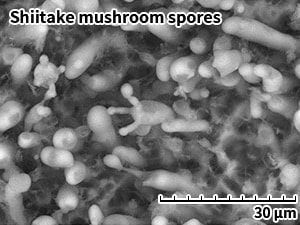
Yeast fungi
Discovery location:Bread
Date of discovery:
Yeast is used in making bread. The yeast cells break down the sugar in the bread dough to produce alcohol and carbon dioxide, in a process called fermentation. This is what causes the dough to rise and also gives bread its flavor.Yeast is a type of single-celled fungus, and it's used particularly for making bread. It has a round shape and is up to five micrometers in size, and both fresh yeast and dry yeast can be used to make bread. Fresh-yeast fungi look puffier than dry-yeast fungi.
Yeast cells reproduce by sprouting a bud and splitting off to form a separate cell.
Powdered dry yeast is a type of yeast fungi is an essential part of the bread-making process.
Both fresh yeast fungi and dry yeast are living organisms, but dry yeast is drier, which makes it easier to store at home for a long time.

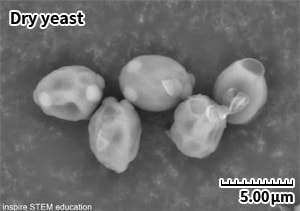
Aspergillus mold
Discovery location:Miso and soy sauce
Date of discovery:
Aspergillus mold is used to make traditional Japanese foods like miso and soy sauce, and also sake (Japanese rice wine).Aspergillus mold grows by extending out threads called "hyphae." The tips of these hyphae secrete substances called "enzymes," which break down proteins and carbohydrates, which means they break down soybeans, rice, and barley. This process is called fermentation. This process is used to make a variety of fermented foods. Fermented soybeans can be made into miso and soy sauce, and fermented rice and barley can be made into alcohol.
The spores are very small, only a few micrometers in size, and they have lots of little bumps on their surface.
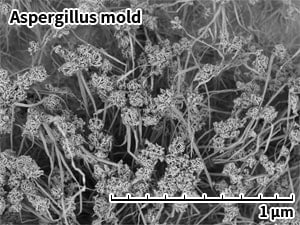
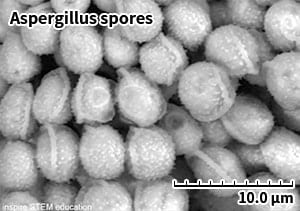
Blue mold
Discovery location:Tangerine/orange
Date of discovery:
When you look at the blue-green mold that grows on oranges and other citrus fruits through an electron microscope, you can see the thread-like "hyphae" stretched out over the food in a webbed pattern.The mold extends its hyphae to take in nutrients from the food. The hyphae thicken to form a stalk. Spores are released from the tip of this stalk, which is how the mold propagates.
In the blue mold in the photo, the spores at the tips of the stalks are arranged in lines, making them look like flowers in bloom. The spores are slightly flat in shape, with an indentation in the center.
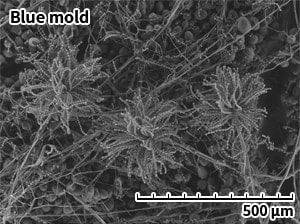
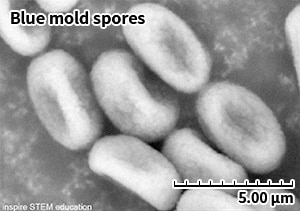
Natto bacteria*Watch out — this is not a mold!
Discovery location:Natto (a Japanese fermented soybean dish)
Date of discovery:
The natto bacteria in natto (a Japanese fermented soybean dish) is a type of bacteria known as "hay bacillus." Hay bacillus are bacteria found in the soil and on plants, and are not a type of mold.Like aspergillus and yeast fungi, natto bacteria can produce substances called enzymes, which break down proteins and carbohydrates.
The Japanese fermented soybean dish natto is made by wrapping soybeans in rice straw. The straw contains naturally occurring natto bacteria, which produce enzymes that ferment the soybeans and produce natto.
Natto bacteria are shaped like neat ellipses (elongated circles) a few micrometers in length.
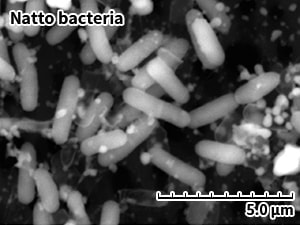
Black mold
Discovery location:Wall
Date of discovery:
You've found black mold on the wall!Black mold appears blackish to the naked eye, and is one of the most common molds found in homes. This mold is quick to grow in damp places like the bathroom and the kitchen if left untreated, as well as on food.
If you look very closely at the black mold, you can see many spores collected at the tips of the stalks formed by the hyphae. These spores float through the air and end up in lots of different places, and that's how the mold propagates. What we call "black mold" isn't actually one specific type of mold, but lots of different ones. The shape of the spores and the way they stick to the tips of the stalks differs depending on the type of mold.
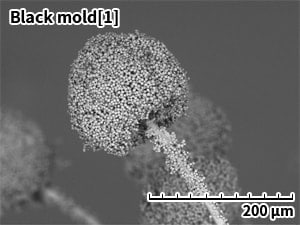
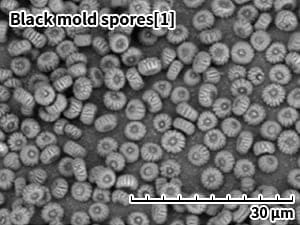
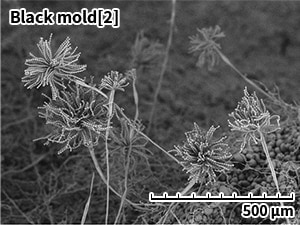
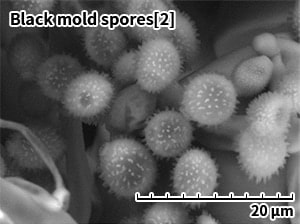
We've learned that the different types of mold have different shapes when we look at them on a microscopic level. Why not try looking around to see if you can find any of our moldy friends around you?
